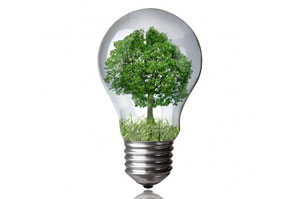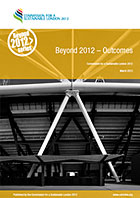
Commitments
ODA
The ODA committed that:
- Across the Site as a whole, sufficient on-site renewable energy generation capacity shall be installed to meet at least 20 percent of the annual carbon emissions of the venues and other buildings to be retained within the Site in the Legacy phase. (Planning Conditions, LTD1.3)
This commitment was also contained within the ODA Sustainable Development Strategy and forms part of a wider commitment on carbon reduction.
- The ODA aspires to achieve a reduction in carbon emissions for the built environment of 50 per cent by 2013 (ODA Sustainable Development Strategy).
This was also listed as a commitment in the London 2012 Sustainability Plan, 2nd Edition, December 2009
LOCOG
When bidding to host the Games London 2012 made this commitment:
- At Games time, 20 per cent of Olympic Park electricity requirements will be met by new local renewable energy sources: e.g. advanced waste-to-energy technologies, photovoltaic panels, small scale wind turbines, bio-diesel generators and micro-co-generation for public lighting venue, accommodation, and electric vehicle power. All additional site electricity demand will be imported from off-site renewables, e.g. wind farms and marine current turbines.
This was re-iterated in the London 2012 Sustainability Plan, which stated that they will supply 20 per cent of Olympic Park electricity requirements at Games-time from new local renewable energy sources.
For the purposes of this target, local was provisionally defined as Greater London, plusThurrockand North Kent Thameside. Games-time is the 77 day period from 27 June 2012 (when the Main Media Centre opens) until 12 September 2012 (when the Main Media Centre andParalympicVillageclose).
In the London 2012 Sustainability Plan, LOCOG and its Sustainability Partner, EDF Energy, committed to providing a low carbon fuel solution for the flames of the Olympic torch and the cauldron.
OPLC
The OPLC inherits the ODA targets of
- 50% carbon reduction in the operation of the built environment by 2013 and
- 20% of energy in legacy to come from onsite renewable sources.
In addition, housing built after 2016 will need to comply with Government plans for zero carbon homes.
Plans being developed
The ODA adopted an approach of lean, mean, green:
- Lean – Minimising the energy demand, through building energy efficient venues.
- Mean – Supplying heat, cooling and power from an on site energy centre. This further reduces their carbon emissions.
- Green – Generate heat and power from renewable sources.
The ODA originally intended that a significant proportion of the target would come from a large wind turbine situated to the north of the Olympic Park. Plans for this were dropped after it emerged that new health and safety legislation would impact on the preferred turbine and that it was not likely to be possible to resolve all the issues to allow for construction before the Games. The Commission supported this decision on the condition that we still expect the ODA to meet its overall 50% carbon reduction target. The Commission made a statement on this, which can be found here.
In April 2011 the ODA announced that they would not be able to meet their 20% renewable energy target as the alternatives they had considered since dropping their plans for the wind turbine were not viable or would not provide sufficient power to meet the target. The Commission accepted this decision being assured that the ODA had extensively explored the opportunities to achieve the 20% target using financially viable renewable energy solutions and that an alternative investment programme would enable the ODA to meet the shortfall that would otherwise occur in its carbon reduction commitments. An official statement by the Commission can be found here.
The ODA will now deliver 9% renewable energy in legacy, coming from a combination of biomass boilers in the energy centre, solar photovoltaic panels on the Media Centre and Media Centre Car Park and a small contribution from micro wind turbines. This contributes to an overall projected carbon reduction of 43%, against a target of 50% reduction. To make up the shortfall the ODA are investing in energy efficiency schemes in boroughs surrounding the Park through the Mayor’s RE:NEW and RE:FIT schemes.
LOCOG is also not able to meet its Games-time renewable electricity target, having been unable to secure viable temporary renewable electricity generation equipment or find viable ways of investing in new local renewable generation. They will instead be focusing on reducing electricity consumption during the Games with the intent to deliver at least the equivalent carbon savings. The Commission supports this approach in principle and looks forward to reviewing the detailed figures showing how this will be achieved. We have requested detailed calculations showing the carbon that would have been saved through renewable electricity and how at least this much carbon will be saved through reducing Games-time energy use. A recommendation around this was made in our 2010 Annual Review, progress against the recommendation can be checked using our recommendation tracker.
In June 2011 EDF Energy announced that it would not deliver a low-carbon fuel for the Olympic torch, The Commission is disappointed that they failed to deliver this commitment. The carbon contribution of this initiative may have been relatively small, but the power of the message across the globe would have been highly significant. The Olympic torch is a universal symbol of the Games, and a low-carbon torch would have been an unequivocal demonstration ofLondon’s commitment to a truly sustainable Games. The promise of a low-carbon torch was made in 2007 and so the excuse of “we ran out of time” is not acceptable. While we acknowledge that EDF Energy invested considerable effort into the low-carbon torch concept, this is a project with an immovable deadline and therefore commitments must be delivered.”
The Commission is also aware that EDF Energy has made various claims about low carbon energy supply and their association with the Games, including that “every unit of electricity that EDF Energy supplies to London 2012 during the Games will be matched with power generated from low carbon sources”.
We have advised LOCOG to draw a clear distinction between how they report new and existing low carbon supply sources, making it clear what has been commissioned for the Games, and what is existing low carbon generation. Where the Games are to be supplied from existing sources, the supplier’s other customers will be supplied with less, having no net impact on the environment. We are pleased to note from the London 2012 Sustainability Report (April 2011) that LOCOG has based its carbon footprint estimates for Games-time venue energy use on the current grid average figures. The Commission made a statement on this subject in August 2011.
LOCOG are currently considering options for a low carbon cauldron and the Commission’s Chair, Shaun McCarthy wrote a blog on this subject in November 2011.
The OPLC is considering its options for meeting the Government’s intention that new homes from 2016 be zero carbon. The Commission has recommended that they develop an integrated waste and energy strategy for the legacy developments on the Olympic Park. This should use organic waste to derive biogas and maximise the renewable energy available to the legacy communities and facilities, with the ultimate aim of creating an exemplar zero carbon community in the Lower Lea Valley.
